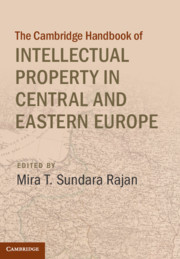Book contents
- The Cambridge Handbook of Intellectual Property in Central and Eastern Europe
- The Cambridge Handbook of Intellectual Property in Central and Eastern Europe
- Copyright page
- Dedication
- Epigraph
- Contents
- Figures
- Tables
- Contributors
- Foreword
- Acknowledgements
- 1 General Introduction – Intellectual Property in Central and Eastern Europe:
- 2 The Patent System in Pre-1989 Czechoslovakia
- 3 The Development of Hungarian Copyright Law until the Creation of the First Copyright Act (1793–1884)
- 4 Moral Rights and the Cultural Aspects of Hungarian Copyright Law:
- 5 The Polish Struggle with the Concept of Copyrightable Work:
- 6 Comparing Concepts of Originality in EU, Lithuanian, and US Law:
- 7 The Comparative Lessons of Itar-Tass Russian News Agency v. Russian Kurier
- 8 Communication to the Public under Union Law from the Perspective of Austrian and German Copyright Law: A Notion in Transition
- 9 Collective Management of Copyright in Hungary1
- 10 Exceptions and Limitations:
- 11 The Digitization of Czech Cultural Heritage and New Forms of Information Exclusivity
- 12 The Treatment of Authors’ Moral Rights in Georgia
- 13 Performers’ Rights: A Central European Export
- 14 The White Elephant in the Room:
- 15 A Central and Eastern European Perspective on EU Copyright Reform:
- 16 The Painter, the One Horn Cow, and Ole Hank Wilson’s Back Lot:
- 17 Does Paying Innovative Employees Pay Off?:
- 18 Intellectual Property Rights in Albania:
- 19 The Protection of Geographical Indications for Agricultural Products in the European Union
- 20 Legal Protection of the Traditional Knowledge and Traditional Cultural Expressions of the Indigenous Peoples of the Former Soviet Union*
- Index
6 - Comparing Concepts of Originality in EU, Lithuanian, and US Law:
Photographs, News Clips, Databases, Plot Lines, TV Formats, and Other New Uses of Copyright Works
Published online by Cambridge University Press: 11 June 2019
- The Cambridge Handbook of Intellectual Property in Central and Eastern Europe
- The Cambridge Handbook of Intellectual Property in Central and Eastern Europe
- Copyright page
- Dedication
- Epigraph
- Contents
- Figures
- Tables
- Contributors
- Foreword
- Acknowledgements
- 1 General Introduction – Intellectual Property in Central and Eastern Europe:
- 2 The Patent System in Pre-1989 Czechoslovakia
- 3 The Development of Hungarian Copyright Law until the Creation of the First Copyright Act (1793–1884)
- 4 Moral Rights and the Cultural Aspects of Hungarian Copyright Law:
- 5 The Polish Struggle with the Concept of Copyrightable Work:
- 6 Comparing Concepts of Originality in EU, Lithuanian, and US Law:
- 7 The Comparative Lessons of Itar-Tass Russian News Agency v. Russian Kurier
- 8 Communication to the Public under Union Law from the Perspective of Austrian and German Copyright Law: A Notion in Transition
- 9 Collective Management of Copyright in Hungary1
- 10 Exceptions and Limitations:
- 11 The Digitization of Czech Cultural Heritage and New Forms of Information Exclusivity
- 12 The Treatment of Authors’ Moral Rights in Georgia
- 13 Performers’ Rights: A Central European Export
- 14 The White Elephant in the Room:
- 15 A Central and Eastern European Perspective on EU Copyright Reform:
- 16 The Painter, the One Horn Cow, and Ole Hank Wilson’s Back Lot:
- 17 Does Paying Innovative Employees Pay Off?:
- 18 Intellectual Property Rights in Albania:
- 19 The Protection of Geographical Indications for Agricultural Products in the European Union
- 20 Legal Protection of the Traditional Knowledge and Traditional Cultural Expressions of the Indigenous Peoples of the Former Soviet Union*
- Index
Summary
Issues in copyright law such as the appropriate term of protection, the ability of copyright regimes to embrace (or at least adjust to) new modes of production and new concepts of authorship, and the proper allocation of benefits to authors and the public have generated intense and highly visible debates on both sides of the Atlantic Ocean. It may therefore be helpful to take a different perspective and examine a less strident issue like originality to see how it is applied to newer uses like digital media, photographs, news footage, and TV formats. Such was the inspiration for this chapter: to examine the foundational concept of originality in the copyright schemes of Lithuania, the EU, and the United States in order to make some observations about the similarities and differences in statutes and case law in each jurisdiction. The hope is to provide some guideposts for how the respective courts understand the concept of originality and look at how such concepts have been applied in practice when determining whether or not a work is deserving of copyright protection in the first instance. What follows does not claim to be an exhaustive treatment of the subject of comparative concepts of originality. Rather, it is the authors’ attempt to select illustrative and engaging cases (and doctrines) to extract the principles – sometimes clearly articulated, at times less so – that inform views in these respective legal systems, and that may also be common across borders. As practitioners, we also have the modest ambition of providing an analytical frame of reference that may prove useful to fellow lawyers who find themselves tackling questions of whether new types of works or new uses of works are in fact original enough to merit copyright protection.
- Type
- Chapter
- Information
- Publisher: Cambridge University PressPrint publication year: 2019
- 1
- Cited by



